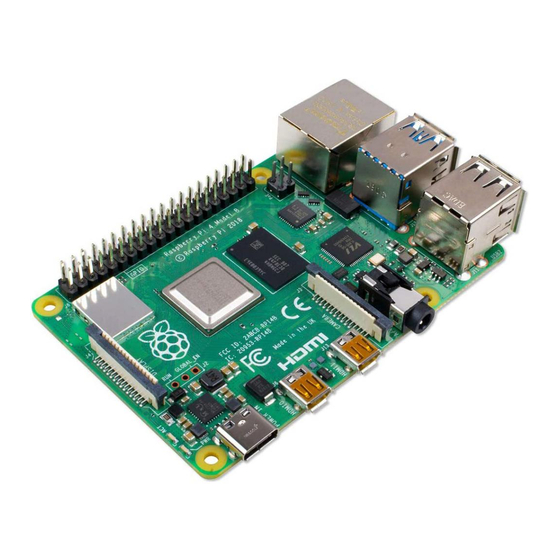Advertisement
Quick Links
Installation Guide for Raspberry Pi 4 Model B
Module Integration
1. Purpose
The purpose of this document is to provide information on how to use a Raspberry Pi 4 Model B as a
radio module when integrating into a product.
Incorrect integration or use may infringe compliance rules meaning recertification may be required.
2. Module Description
The Raspberry Pi 4 Model B+ module has an IEEE 802.11b/g/n/ac 1x1 WLAN, Bluetooth 5 and
Bluetooth LE module based on the Cypress 43455 chip. The module is designed to be mounted, with
appropriate screws, into an end product. The module must be placed in a suitable location to ensure
WLAN performance is not compromised. The module contains an on-board dual band WLAN +
Bluetooth antenna.
Advertisement

Subscribe to Our Youtube Channel
Summary of Contents for Raspberry Pi 4 B
- Page 1 Module Integration 1. Purpose The purpose of this document is to provide information on how to use a Raspberry Pi 4 Model B as a radio module when integrating into a product. Incorrect integration or use may infringe compliance rules meaning recertification may be required.
- Page 2 3. Integration into Products Module & Antenna Placement A separation distance greater than 20cm will always be maintained between the antennas and any other radio transmitter if installed in the same product. The module is physically attached and held in place by screws In order to connect the module to the system micro USB power cable is connected to J1 on the board.
-
Page 3: Antenna Information
Micro HDMI AUDIO Ethernet USB2.0 and USB3.0 ports DSI Display (for use with Official Raspberry Pi display, sold separately) CSI Camera (for use with Official Raspberry Pi Camera module, sold separately) ETHERNET USB3.0 DISPLAY USB2.0 Any external power supply used with the Raspberry-Pi shall comply with relevant regulations and standards applicable in the country of intended use. -
Page 4: End Product Labelling
5. End Product Labelling A label is to be fitted to the exterior of all products containing the Raspberry Pi 3 Model B+ module. The label must contain the words “Contains FCC ID: 2ABCB-RPI4B” (for FCC) and “Contains IC: 20953- RPI4B”... - Page 5 Caution: Any changes or modifications to the equipment not expressly approved by the party responsible for compliance could void user s authority to operate the equipment. This equipment has been tested and found to comply within the limits for a Class B digital device, pursuant to part 15 of the FCC Rules.
-
Page 6: Important Note
ISED Raspberry Pi 4 Model B IC: 20953-RPI4B This device complies with Industry Canada license-exempt RSS standard(s). Operation is subject to the following two conditions: (1) this device may not cause interference, and (2) this device must accept any interference, including interference that may cause undesired operation of the device. - Page 7 INTEGRATION INFORMATION FOR THE OEM It is the responsibility of the OEM / Host product manufacturer to ensure continued compliance to FCC and ISED Canada certification requirements once the module is integrated in to the Host product. Please refer to FCC KDB 996369 D04 for additional information. The module is subject to the following FCC rule parts: 15.207, 15.209, 15.247, 15.403 and 15.407 Host Product User Guide Text FCC Compliance...
- Page 8 This device complies with Industry Canada license-exempt RSS standard(s). Operation is subject to the following two conditions: (1) this device may not cause interference, and (2) this device must accept any interference, including interference that may cause undesired operation of the device. Le présent appareil est conforme aux CNR d'Industrie Canada applicables aux appareils radio exempts de licence.
- Page 9 Important Notice to OEMs: The FCC Part 15 text must go on the Host product unless the product is too small to support a label with the text on it. It is not acceptable just to place the text in the user guide. E-Labelling It is possible for the Host product to use e-labelling providing the Host product supports the requirements of FCC KDB 784748 D02 e labelling and ISED Canada RSS-Gen, section 4.4.



Need help?
Do you have a question about the 4 B and is the answer not in the manual?
Questions and answers